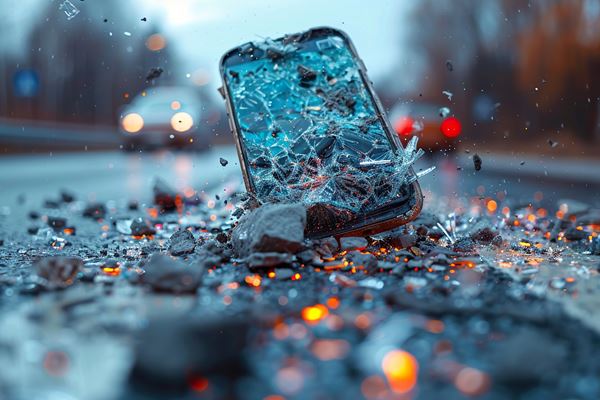Trucking Attorneys: How To Use Protocols and Negotiations To Get Cell Phone Data From the Opposing Side

Cell phones can contain a wealth of information that can make or break a trucking accident case. When it comes to distracted driving, the electronic data on these devices often holds the key to understanding what happened in the moments leading up to an accident.
Cell phones are our constant companions in our modern world, serving as digital concierges that manage our personal and professional lives. It’s understandable, then, that clients and their counsel are concerned about turning over cell phone data, which often contains sensitive personal information far beyond the scope of any single case.
Adding to these privacy concerns is the reality of how cell phone forensics works. A technical challenge that many outside the field of digital forensics are not aware of is that when we extract data from a cell phone using forensic tools and methods, we have to collect everything upfront.
It’s not like rifling through a filing cabinet where we can selectively pull out relevant documents. Instead, it’s more like making a complete copy of the filing cabinet's contents before we can start sorting through it.
This all-or-nothing approach often creates friction in the discovery process. Opposing counsel may balk at handing over a complete digital copy of their client’s phone, even if you assure them that only specific information will be analyzed. However, these objections can often be overcome with well-crafted protocols and negotiations.
The Problem: We Have to Collect It All
Data on a cell phone does not exist in isolation. The interdependence of different data types and how they relate to one another is one of the primary reasons why forensic experts and tools cannot selectively collect data during a cell phone forensics examination.
Doing so is not technically possible in almost all instances, and even if it was, it could compromise the integrity of the evidence and lead to incomplete or misleading conclusions.
Technical Realities
- Relational Databases and App Dependencies: Many cell phones use relational databases to store data, with different tables linked by references. For example, a contact entry in the address book may be linked to call logs, messages, and app data. If only a portion of this interconnected data is collected, these links could be broken, making it challenging or impossible to piece together a coherent picture during forensic analysis.
- Cross-Referencing and Data Integrity: On cell phones, text messages, call logs, photos, videos, emails, and app data are often intertwined. For instance, a text message carries a timestamp that can be cross-referenced with location data, call logs, or social media activity to establish a comprehensive timeline of events. If an expert were to collect only the text message without the corresponding location or call log data, the context and significance of that message could be lost.
- Contextual Importance of Data: The value of specific pieces of data is frequently derived from their relationship with other data. A single message might seem trivial in isolation but could take on new importance when viewed within the broader context of related communications, app usage, or location history. Forensic experts preserve this context by collecting all data, ensuring that the complete narrative can be accurately reconstructed.
- Recovering Hidden Data: Phones often contain hidden files, system logs, and deleted data that can be crucial to a case. These aren’t accessible through the phone’s normal interface. A complete forensic cell phone extraction allows our specialized tools to recover this hidden information.
Legal Considerations
- Limited Access to the Device: Your expert may have limited access to the phone. For example, a driver’s phone might only be available for forensic data extraction on a specified date and then returned following the extraction. This is the only opportunity to ensure everything is collected as a "perfect snapshot in time" since the driver's continued use of the phone will change the data.
- Future-Proofing the Investigation: In some cases, new evidence or technologies may emerge after the initial investigation that can reveal previously hidden or inaccessible data. By collecting everything initially, forensic experts ensure that all data is preserved and can be re-examined, if necessary, even years later. This future-proofing can be essential in complex or long-running cases.
The Solution: Protocols and Negotiations
Protocols
Protocols serve as the essential foundation for negotiations in digital forensics. They provide a structured, transparent framework that guides how data will be handled, helping establish trust and setting the stage for productive negotiations between opposing parties.
Establishing Clear Expectations
Protocols outline the exact steps to collect, preserve, and analyze data from a cell phone. By clearly defining these procedures, protocols help set realistic expectations for both parties.
When both sides understand the process and the safeguards in place, it becomes easier to negotiate on specific aspects, such as the scope of data collection or the parameters for data analysis. This clarity reduces misunderstandings and provides a common ground from which to start negotiations.
For example, a protocol might specify that only data within a certain timeframe or related to specific activities (like texting or calling) will be analyzed.
Knowing this, opposing counsel is more likely to engage in negotiations about the scope of data extraction, as the protocol already limits potential overreach.
Building Trust Through Transparency
Trust is often a significant negotiation barrier, especially when accessing potentially sensitive digital evidence. Protocols build trust by demonstrating a standardized, impartial approach to handling the data.
When opposing counsel can see that strict procedures are in place to protect the integrity of the data and respect privacy concerns, they are more likely to engage in constructive negotiations.
For instance, a protocol might include using a third-party forensic expert who follows established procedures for creating a forensic image of the cell phone. This impartiality helps opposing counsel feel more secure in the process, making them more willing to negotiate the terms of data access and review.
Even when both sides have their own forensic experts, protocols ensure that a standardized approach is taken to collecting and analyzing data. This standardization helps to align the methodologies used by both experts, reducing the risk of discrepancies or conflicts arising from differing practices.
Providing a Basis for Compromise
Negotiations often require compromise, and protocols provide a structured basis for finding a compromise. By outlining what is technically necessary and what steps will be taken to protect both parties’ interests, protocols create a framework for concessions without compromising the integrity of the evidence.
For example, a protocol might state that all data will be collected initially to preserve its integrity, but only specific, relevant data will be reviewed or produced in discovery. This allows both parties to negotiate on what data will be disclosed, knowing that the underlying protocol ensures all data remains intact and available if needed later.
Reducing Areas of Dispute
Protocols can significantly reduce areas of dispute that might otherwise derail negotiations by addressing common concerns upfront. Issues such as how data will be stored, who will have access, and how the data’s integrity will be ensured are often the focus of disputes. When these issues are addressed in a protocol, there is less to argue about, allowing negotiations to focus on more substantive matters.
For instance, if the protocol includes strict guidelines for maintaining a chain of custody and using industry-standard forensic tools, opposing counsel may be less concerned about potential data tampering and more willing to negotiate on the specific terms of data access.
Facilitating a Collaborative Approach
Protocols can also encourage a more collaborative negotiation approach by involving both parties in their creation. When opposing counsel is given a role in shaping the protocol, they are more likely to view it as fair and reasonable. This collaborative process can ease tensions and lead to more productive negotiations, as both sides feel their concerns have been heard and addressed.
For example, in negotiations, the defense and plaintiff counsel could agree to produce only fifteen minutes of data before and after the accident. They could further agree to include all of the data from this timeframe, like messages, emails, and application usage, but the actual contents of the data are redacted.
In other words, there is a timeline of all activities fifteen minutes before and after the accident, but the content of the messages and pictures are redacted.
This would result in a comprehensive timeline of activity, with no personal or private data revealed, only user activity. Your expert could then assist in drafting a protocol that fulfills the requirements determined by the negotiations.
Creating a Roadmap for Future Negotiations
Attorneys often have cases with the same opposing counsel regularly. Protocols act as a roadmap for future negotiations by establishing a precedent for handling digital evidence. Once a protocol has been agreed upon in one case, it can serve as a template for future cases, making subsequent negotiations more straightforward.
Opposing counsel will have a reference point for what has been acceptable in the past, which can expedite the negotiation process in future cases.
For example, if a protocol used in a previous case effectively addressed both sides' concerns, it can be reused or adapted for new cases, reducing the time and effort needed to negotiate similar issues again.
Convincing the Court
Protocols and negotiations are useful for convincing a judge that accessing the opposing side's phone data is relevant and respectful of privacy concerns.
By developing a clear and structured protocol with their expert, an attorney can demonstrate that the data request is narrowly tailored to specific, relevant information, such as device usage or communications during a specific time frame. This approach shows the court that the attorney is not overreaching but is instead focused on critical evidence directly related to the case.
Moreover, by negotiating the protocol with the opposing side, the attorney can highlight the collaborative effort to protect privacy while still allowing necessary evidence to be gathered. This includes safeguards to verify data integrity and prevent data alteration. The involvement of a qualified expert to oversee the process further reassures the judge that the data will be handled responsibly.
These steps help strike a balance between the need for evidence and the right to privacy, making it more likely that the judge will approve the data request.
Conclusion
Negotiations, guided by these protocols, allow us to find a middle ground where the integrity of the evidence is maintained without unnecessarily exposing unrelated personal data. They serve as the bedrock of successful negotiations in digital forensics by setting clear expectations, building trust, providing a basis for compromise, reducing disputes, facilitating collaboration, and creating a roadmap for future cases.
Our experts are ready to help.


